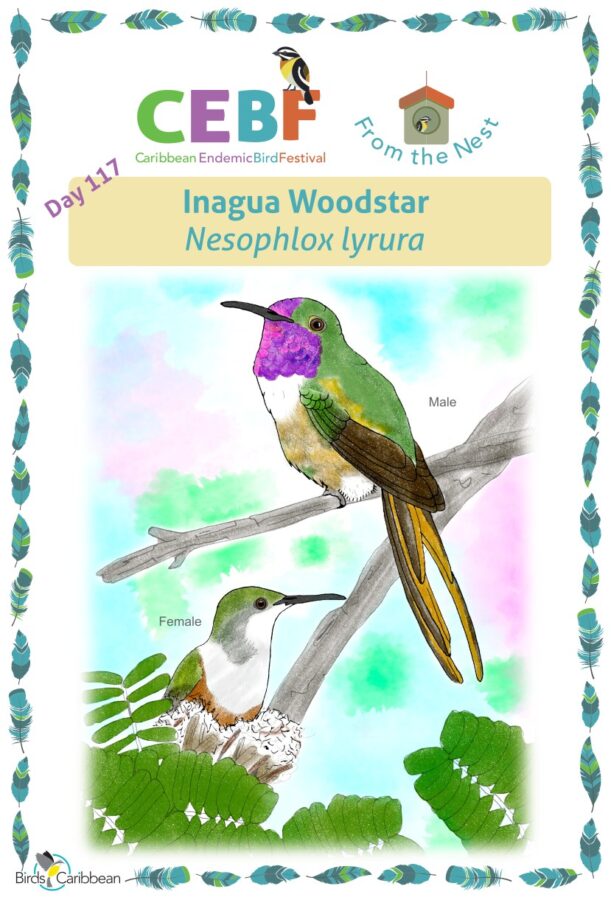Celebrate the Caribbean Endemic Bird Festival (CEBF) with us! Our theme in 2023 is “Water: Sustaining Bird Life,” highlighting the importance of water conservation to both humans and birds. Have fun learning about a new endemic bird every day. We have colouring pages, puzzles, activities, and more. Download for free and enjoy nature with your family at home.
Endemic Bird of the Day: Inagua Woodstar
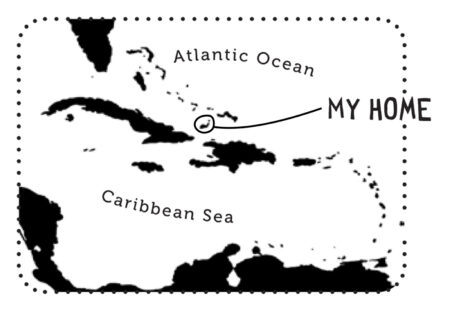 This feisty Bahamian endemic hummingbird was formerly considered a subspecies of the Bahamas Woodstar. But the Inagua Woodstar was classified by the American Ornithological Society as a separate species in 2015. It is found only in Great and Little Inagua, two Islands in the southeastern part of The Bahamas archipelago. The Bahamas Woodstar, however, is found throughout the rest of the Bahamas. Additionally, both species differ from each other in morphology, coloration, vocalizations, and even courtship displays!
This feisty Bahamian endemic hummingbird was formerly considered a subspecies of the Bahamas Woodstar. But the Inagua Woodstar was classified by the American Ornithological Society as a separate species in 2015. It is found only in Great and Little Inagua, two Islands in the southeastern part of The Bahamas archipelago. The Bahamas Woodstar, however, is found throughout the rest of the Bahamas. Additionally, both species differ from each other in morphology, coloration, vocalizations, and even courtship displays!
The male’s iridescent gorget (throat) of both species is a brilliant shade of purple, sometimes chartreuse (yellow-green) if the light catches it just right. But the Inagua Woodstar male may have patches of iridescence on its forehead and lores (area in front of the eyes). Furthermore, adult male Inagua Woodstars have a unique tail—it is slightly longer and more strongly forked than the Bahama Woodstar, and the outer feathers fan out in a unique lyre shape (think of a U-shaped harp).
Female Inagua Woodstars are much like female Bahama Woodstars—dull green on the back, rufous belly, and whitish upper breast and throat. As with most hummingbirds young males closely resemble females until they undergo their first adult molt at about 10 months of age. Young hummingbirds tend to rest on plant leaves instead of hovering when feeding on flowers.
The song of the Inagua Woodstar is quiet and simple, sounding like wet, squeaking shoes. Calls include a sharp, metallic “tit” or “tit-it”; often given in a series, sometimes quite rapidly. Males also make a metallic sound with their tail during display flights.
Woodstars can be found in nearly all habitats, including dune scrub, freshwater riparian areas, parks, and gardens. They visit flowers of numerous native plants including salvia, sages, various honeysuckles, red-bird cactus, aloe vera, Bougainvillea, Noni, and flame of the woods (Ixora) shrubs. The Geiger Trees, however, seem to be a magnet for many male Inagua Woodstars. Both sexes defend territories around favored nectar sources.
Nests may be found anytime from September to June (and possibly year-round) with possible peaks in April-May and October. Nests are usually 3-7 feet off the ground in trees which offer evergreen foliage. In vegetated areas just off the beaches on the eastern side of the islands, nests may be found in various wild scrub plants, about 2-3 ft off the ground. All nests are approximately 2 inches and usually contain two eggs. If you hear the female making repeated calls as you enter a nesting area, she’s telling you “do not come any closer to my nest!” And we hope that you will take heed of of her disturbance warning.
The location of the birds on the islands is highly dependent on the weather in summer and fall, due to the direct influences of hurricanes and the amount of rainfall. While this species is presently common in the Inaguas, it is a restricted range species. It is therefore vulnerable to threats like severe storms and hurricanes, which could wipe out its population directly from the storm itself, or indirectly from destruction of its habitat and the loss of nectar food sources.
Wondering how you can get an up-close look of this endemic gem? Travel to Great Inagua in The Bahamas, where you will fly into Matthew Town, the one small settlement on the island. The locals are helpful with sharing recent sightings and are very willing to give you directions. Please contact these expert local birders/guides for more information: Tarra Lindo Lilninebig@hotmail.com or Casper Burrows Friendlytoursinagua@gmail.com
Thanks to Ann Maddock for the text!
Learn more about this species, including its range, photos, and calls here.
Colour in the Inagua Woodstar
Download our West Indies Endemic Bird colouring page. Use the photos below as your guide, or you can look up pictures of the bird online or in a bird field guide if you have one. Share your coloured-in page with us by posting it online and tagging us @BirdsCaribbean #CEBFfromthenest
Puzzle of the Day
Click on the image below to do the puzzle. You can make the puzzle as easy or as hard as you like – for example, 6, 8, or 12 pieces for young children, all the way up to 1,024 pieces for those that are up for a challenge!
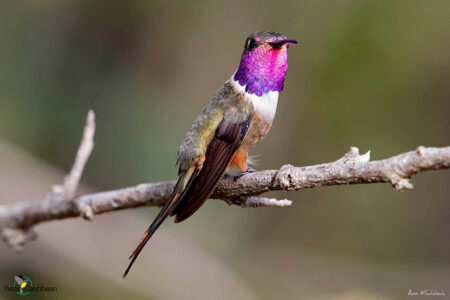
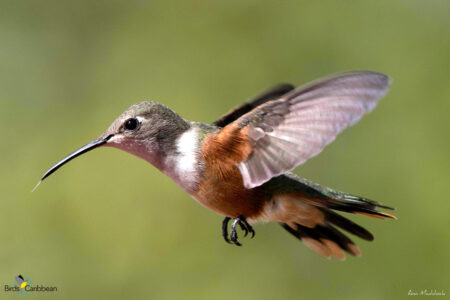
Activity of the Day
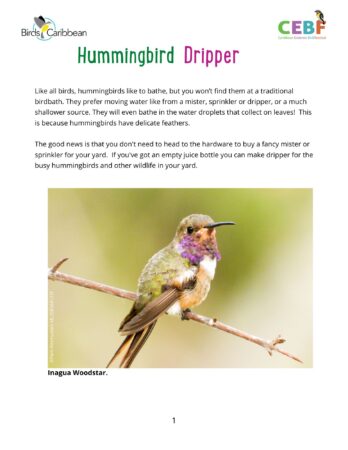 FOR KIDS: Like all birds, the Inagua Woodstar and other hummingbirds like to bathe. But they won’t use a traditional birdbath. They prefer to take a shower in moving water- like from a mister, sprinkler. or dripper, or they use a much shallower source. They will even bathe in the water droplets that collect on leaves!
FOR KIDS: Like all birds, the Inagua Woodstar and other hummingbirds like to bathe. But they won’t use a traditional birdbath. They prefer to take a shower in moving water- like from a mister, sprinkler. or dripper, or they use a much shallower source. They will even bathe in the water droplets that collect on leaves!
Why not make a hummingbird water dripper so that these lovely little birds can take a shower in your garden? If you have an empty juice bottle you can make this dripper. Other wildlife in your yard will also appreciate having some water!
To make the dripper you will need:
- 1 plastic jug or bottle, clean, empty and with labels removed
- craft wire, twine, ribbon, strips of cloth
- 1 straight pin or fine-gauge needle
- Scissors
- Paint or markers (optional)
Be sure to have an adult on hand when using the needle and scissors!
FOR KIDS AND ADULTS: Enjoy this video of an Inagua Woodstar feeding in the wild!
Want to know more about these beautiful endemic birds and other hummingbirds? Why not watch our webinar “Flying Jewels: A Photographic Journey of Select Hummingbird Species of the US and The Bahamas“. In it Ann Maddock shares fascinating information about hummingbirds, using stunning photos from her book of the same name! Ann and our friends from The Bahamas talk about the Cuban Emerald, Bahamas Woodstar, and Inagua Woodstar and how anyone can safely photograph hummingbirds, attract them to your yard, and keep them coming back! First shown as a live Webinar as part of BirdsCaribbean’s Caribbean Endemic Bird Festival 2021.

